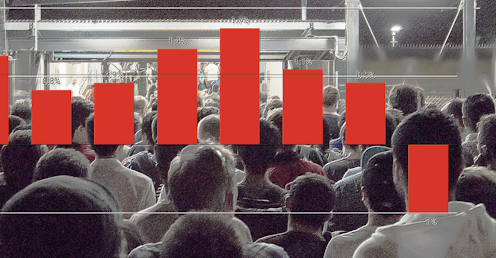Many jobs summit ideas for wages don't make sense – upskilling does
- Written by Michael Keating, Visiting Fellow, College of Business & Economics, Australian National University

This article is part of The Conversation’s series looking at Labor’s jobs summit. Read the other articles in the series here.
Treasury’s issues paper for the jobs summit says fair pay and job security “strengthen communities, promote attractive careers and contribute to broad-based prosperity”.
But it notes “many Australians have not experienced real wage gains”.
It says real (inflation-adjusted) wages have grown by only 0.1% per year over the past decade and have declined substantially over the past year.
It is important to note Australia is not unique.
In Canada, France, Britain and the United States as well as in Australia, real wage growth has been much lower in the 12 years preceding COVID than it was in the decade before that.
The critical question is why. Good policy depends on the answers.
For a long time, the authorities (in Australia, the Treasury and the Reserve Bank) assumed that low wage growth was caused by excessive slack in the labour market – too many unemployed workers available to take jobs, pushing down what could be asked for.
Low unemployment isn’t driving up wages
Unemployment exceeded their estimate of the non-accelerating inflation rate of unemployment (NAIRU), which was believed to be about 5%. The theory was that once unemployment fell below that level, workers would feel more confident about asking for bigger wage increases and employers would feel the need to offer them.
The problem was that as unemployment fell, wage growth still did not recover, or did not recover sufficiently. The authorities responded by lowering their estimate of the NAIRU to somewhere between 4.5% and 5% without changing the model.
But with unemployment now down to 3.4%, and wage growth still low at 2.6%, it might be time to reexamine the model.
Productivity works both ways
The other thing the authorities consider is the rate of growth in labour productivity (output per hour worked). Australia’s productivity growth averaged 2.1% per year from 1989 to 2004 but has since fallen to about 1% per year, the lowest rate in half a century.
The authorities’ model, which assumes perfect competition, constant returns to scale and neutral technological progress implies that real wages can be expected to grow at the same rate as productivity, neither more nor less, making it look as if the collapse in productivity growth explains the collapse in wages growth.
Read more: Are real wages falling? Here's the evidence
But there are problems with this explanation. One is that real wage growth has not always kept pace with productivity growth. In many countries the share of national income going to wages fell as productivity growth was climbing.
Another problem is that low wage growth can contribute to low productivity growth.
Productivity growth depends principally on the adoption of and adaptation to new innovations, which require new investment. However, investment depends principally on consumer demand, which is driven by wages growth.
Wages can drive investment
Private business investment in plant and machinery averaged 6.7% of gross domestic product between 1989 and 2004 but fell to 5.1% after 2004.
It is entirely possible that if we were able to successfully address the structural causes of low wage growth, we could accelerate wages growth and thus consumer demand, which would accelerate productivity growth, giving us wages growth without a wage-price spiral.
So, what are these structural factors slowing wage growth?
The most-discussed suggestions are changed industrial relations settings (including shrinking trade union membership) and technological change and globalisation.
Low-skill jobs are hollowing out
Although there is something in both of these explanations, I put more weight on technological change and globalisation in part because other countries with different industrial relations systems also experienced weak wage growth, and also because the hollowing out of occupations clearly played a role and it is hard to see how the industrial relations system could have contributed to this.
Read more: The Chalmers graphs: 7.75% inflation, plunging real wages, weak growth
The argument is that technological change and globalisation have hollowed out routine middle-level jobs, depressing pay in these occupations relative to higher-paid occupations.
This means programs to lift wage growth should focus on improving the capacity of the labour market to adapt to new technologies, which means retraining.
As the workforce upskills, wages will increase as workers shift to higher-paid jobs where workers are in short supply.
Thomas Piketty put it this way in his major study of inequality:
the best way to increase wages and reduce wage inequalities in the long run is to invest in education and skills
Although skills, training and migration are listed as key topics for the jobs summit, the treasury’s issues paper focuses almost entirely on industrial relations in its discussion of how best to boost wages.
Read more https://theconversation.com/many-jobs-summit-ideas-for-wages-dont-make-sense-upskilling-does-189114





